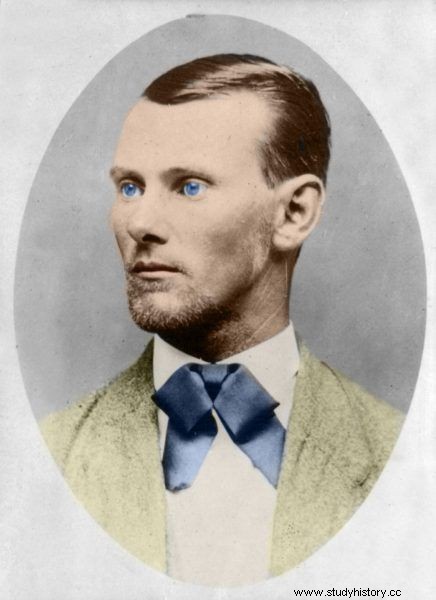The legendary figure of the most famous gunslinger in the Wild West became a source of imagination for the authors of books and films. The mysterious account of Calamita Jane added fuel to the fire - did Jesse James survive the betrayal, and someone else was buried in the grave?
“Most of the DNA ... is contained in the nucleus, but some is contained in the mitochondria. […] Both male and female offspring receive mitochondrial DNA from the egg, but only female offspring can pass these genes on to their offspring. Hence, it is said that every woman that has ever lived is bound by mitochondrial DNA to the first woman, the so-called mitochondrial Eve ”Writes Joseph Le Doux in his latest book The History of Our Consciousness . But what does this have to do with the story of one of the Wild West's most famous bandits?
From zero to (anti) hero
Jesse James was a straight out (literally) character from a western. He was born on September 5, 1847 in Missouri. He took part in the Civil War as a member of a Confederate support group. Even then, he showed a tendency to carelessly shed blood:he was involved in numerous acts of violence against unarmed Union soldiers and civilians . He was one of the perpetrators of the massacre in Centria, where 24 defenseless supporters of the Army of the North were murdered.
No wonder that immediately after the end of the fighting, he and his brother and cousins started criminal activities - they attacked banks, stagecoaches and trains. They were most active in the years 1866–67. They went down in history as the James-Younger Gang. And despite their ruthless "work" methods, they enjoyed some popularity.
The group's first stumble occurred during a failed bank robbery in Northfield, Minnesota. Many gang members were killed or captured at the time because the cashier refused to open the safe and the people of Northfield realized the bandits' intentions and opened fire . Only the James brothers remained alive and free.
Jesse continued, and was joined by more "outlaws", but the pressure from the authorities became too much. Rumors had it that the criminal became extremely distrustful of the new members of the group - so much so that he reportedly shot one of them "just in case". It turns out he was right. The legendary bandit was killed by one of the new "acquisitions" of the gang, Robert Ford. The recruit was hoping to win a substantial prize for Jesse James's head.

Portrait of Jesse James
It all happened at the James house, where the Ford brothers Robert and Charley had moved in to give the "boss" better protection against the impending specter of justice. Little did Jesse know that even then, Robert was secretly negotiating with the Governor of Missouri, Thomas T. Crittenden. Just in time, when he was behind James' back, he pulled out his gun and shot him in the back of the head.
The Ford brothers did not hide their role in "neutralizing" the criminal. Law enforcement officials arrived at the house and arrested them on suspicion of murder. A trial was held on the same day, they were found guilty and sentenced to death by hanging, and then pardoned . The governor paid them part of the prize (the remaining money went to the sheriff and marshal), and the brothers left. Charley Ford committed suicide on May 6, 1884, and Robert was killed on June 8, 1892 by Edward O'Kelley.
Voices from beyond the grave
Jesse James was buried on the family property; later the body was moved to Kearney Cemetery. Except… not everyone believed it was really his corpse!
The shotgun was identified by scars from previous gunshot wounds and a partially missing middle finger. However, the spread of rumors took hold of the minds of a keenly interested public. Perhaps everything was made up? Maybe Robert Ford - Jesse's trusted friend - shot someone else and the real thug ran away?

The text is based on the latest book by Joseph LeDoux, "The History of Our Consciousness", which has just been published by the Copernicus Center Press.
Oil was added to the fire by an account in the journals of Calamity Jane, who claimed to have met Jesse 7 years after his death. According to her version of events, the hero of the nation, Dziki, Bill Hickok, was buried in the coffin. Moreover, Jesse James was allegedly told to Jane that he planned to see her 100th birthday and then admit her true identity ...Meanwhile, the myth continued. In the 1940s, a man named Frank Dalton announced that he was Jesse James. These kinds of theories are usually taken with a pinch of salt, but there was a certain possibility that Calamity Jane was right. Unfortunately - as is often the case - science has dispelled all doubts (probably spoiling the fun of a few enthusiasts of fantastic stories from the Wild West). As we read in The History of Our Consciousness Joseph Le Doux:
One-parent mitochondrial DNA inheritance was used to prove that the notorious 19th century bank robber Jesse James was indeed buried in a grave bearing his name.
There were some doubts as to whether the robber had faked his death to hide from justice under a different name. But comparing the DNA of the hair and teeth retrieved from the grave with the mitochondrial DNA of two living men [...] who were descendants of James's sister, Susan, and her descendants [...] ultimately settled the matter. The same method is used to identify the remains of unknown soldiers in the war.
However, in a sense, Jesse James actually "survived" the attack and secured his immortality - in the pages of novels and cinema screens ...
Bibliography:
- LeDoux, J., The History of Our Consciousness, Copernicus Center Press 2020.
- Settle, W. A., Jesse James Was His Name, or, Fact and Fiction Concerning the Careers of the Notorious James Brothers of Missouri, University of Nebraska Press 1977.
- Stiles, T. J., Jesse James:Last Rebel of the Civil War, Knopf Publishing 2002.
